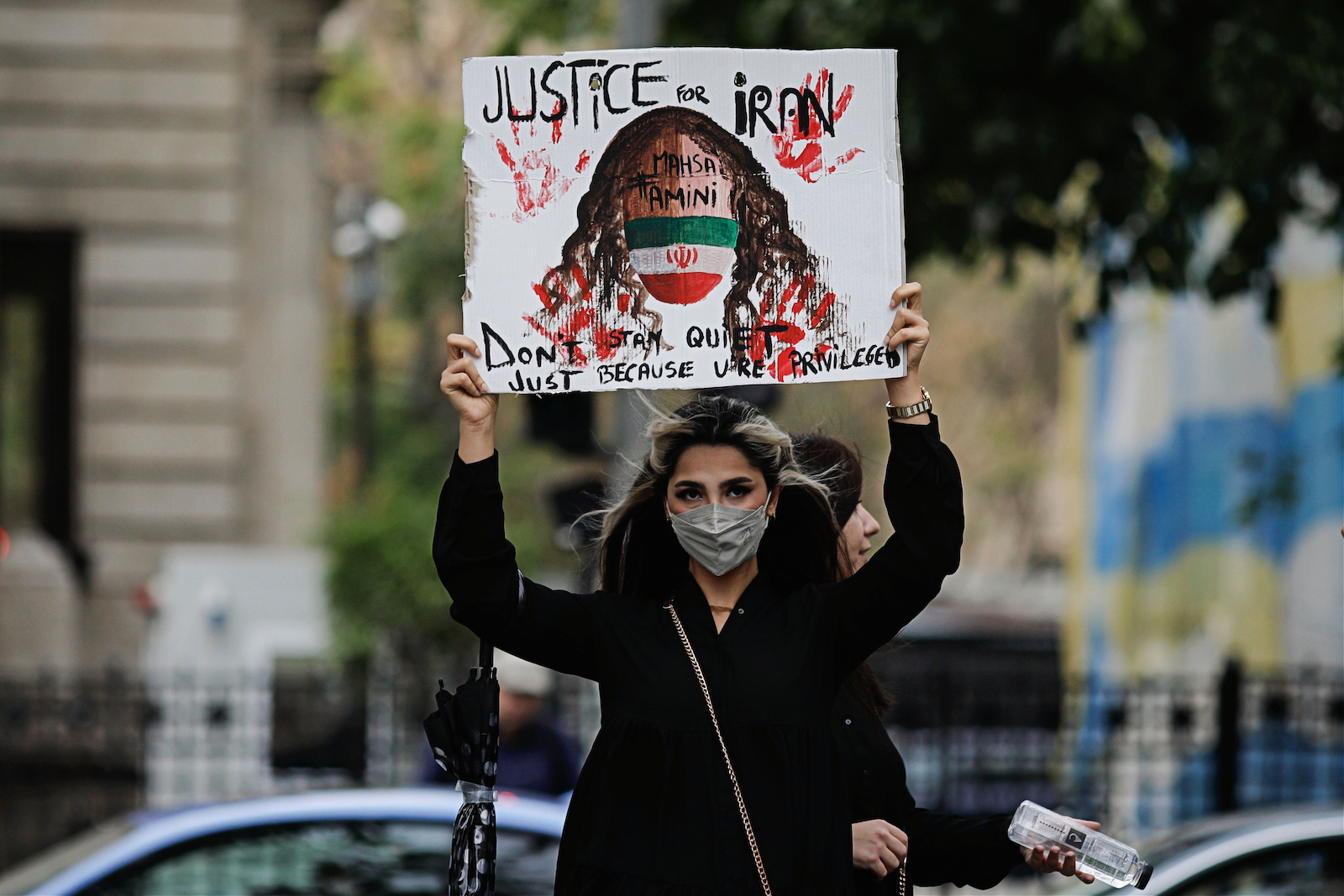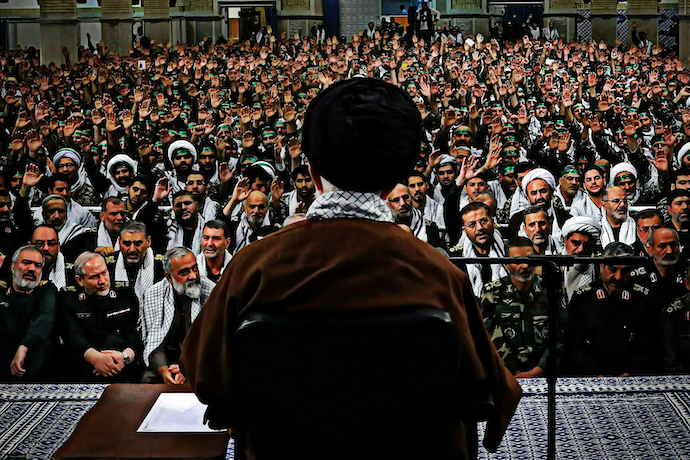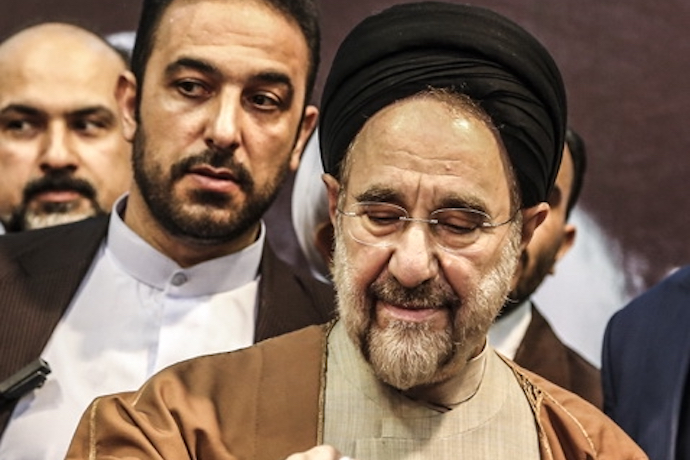
Olive Branch and Iron Fist: Tehran’s Survival Handbook
On September 16, Iran marks the first anniversary of a transformative wave of protests that engulfed not just its bustling cities but also its rural heartlands. Dubbed “Woman, Life, Freedom” (WLF), the movement was a visceral response to the tragic death of Mahsa Amini—a young woman arrested and detained by Iran’s morality police for contravening the Islamic dress code for women, better known as the hijab law.
Amini’s arrest was not an isolated case; Iranian women have often faced the relentless coercion of morality police for perceived dress code infractions. However, it was the gut-wrenching video of Amini’s collapse in custody that served as the fulcrum for a seismic shift. In mere days, thousands of young women and men took to the streets, giving rise to protests that mushroomed across the nation. Far from bystanders, university students emerged as visible, fervent participants in this civil unrest.
At the heart of the WLF protests were women who audaciously pushed the boundaries of political dissent. Casting aside their headscarves in a coordinated act of defiance, they became the emblematic figures of a nation grappling with long-simmering tensions.
In the face of these unparalleled demonstrations, the ruling Islamic regime adopted a two-pronged strategy—a nuanced approach that warrants closer examination below.
An ‘Iron Fist’ domestic response
In the initial weeks, the protests proliferated at a startling pace, creating a cacophony of voices clamoring for change. Among political analysts and observers, there was rampant speculation that this unrest could serve as a catalyst for sweeping political reform, if not an outright regime change. These predictions, as it turned out, were premature.
Caught off guard, the regime initially refrained from deploying brute force to suppress the demonstrators. But as the weeks wore on, a pivotal shift occurred within the corridors of power. A decision was reached at the highest echelons of power to confront the protests head-on, employing force as a means to contain this burgeoning civil disobedience.
The regime’s strategic pivot points to the complexities and inherent challenges of navigating civil unrest in a nation marked by long-standing political tensions. And so, what began as a moment teetering on the precipice of transformation ultimately found itself corralled, once again, by the heavy hand of governance.

As the protests unfolded, they were mirrored in real-time on social media, engendering a groundswell of international solidarity. Mindful of global scrutiny and wary of reprising the brutal tactics employed during the 2019 uprisings, the regime was circumspect about resorting to large-scale lethal force. However, it still sought to instill a climate of fear potent enough to dissuade the broader populace from joining the demonstrations.
The machinery of repression operated with chilling efficiency. Tactics ranged from torture to the severe battering of protesters—especially young women. Iran’s security forces wielded BB guns and shotguns, aiming deliberately at the faces of dissenters. Although the daily death toll remained relatively low, injuries were both widespread and grotesque. Countless protesters sustained severe facial injuries, with many losing their eyesight as a grim consequence.
The regime’s suppression also had a carceral dimension. Over the course of four months, nearly 90,000 demonstrators were rounded up, and subjected to various forms of abuse and torture. This multifaceted campaign—leveraging violence, intimidation, and mass arrests—ultimately achieved its aim. By January, the pulsating energy of the protests had largely dissipated, a glaring testament to the regime’s coldly calculated strategy to muzzle dissent.
The decline of the protests sheds light on the regime’s deft application of coercion and force, a study of the mechanisms that quell a citizenry on the brink of boiling over.
Based on recent revelations from regime insiders, the initial weeks of the uprisings instilled a sense of palpable anxiety among regime loyalists and clerics. Some even harbored fears that the protests might, against all odds, succeed in effecting change. Despite these apprehensions, the upper echelons of the regime remained unwavering in their resolve to confront the protesters, forgoing any concessions, and relying almost exclusively on state-sanctioned violence to subdue the unrest.
One of the more remarkable outcomes of these uprisings was their revelation of the deep-seated animus millions of Iranians harbored against their government and its policies. The slogans that reverberated through the streets and ricocheted across social media transcended mere critiques of the regime’s repressive cultural dictates. They voiced an unambiguous rejection of the Islamic regime in its totality. The caustic tone of these expressions—some of which included profanities aimed directly at Supreme Leader Ali Khamenei —further galvanized the regime’s commitment to suppressing the protesters without concession or compromise.
In the wake of its relatively successful quelling of the demonstrations, the regime issued an amnesty in February, liberating thousands who had been arrested. Yet, this gesture should not be mistaken for magnanimity. Selective prosecutions and punishments have continued apace; over the past eight months, several protesters have been executed, and many more have been handed lengthy prison sentences.
The regime’s actions in the aftermath of the protests—oscillating between token amnesties and persistent punitive measures—offer a lens through which to understand its complex, and often contradictory, strategies for maintaining its grip on power in a nation on the cusp of revolt.

In addition to direct repression, the Islamic regime has deployed a host of ancillary tactics designed both to instill fear and to telegraph its unyielding stance in the face of public dissent. Among these is the wholesale expulsion of hundreds of university professors and educators, replaced summarily by regime loyalists whose ideological fidelity trumps their professional qualifications. Advanced surveillance systems, bolstered by traffic cameras, are now trained to identify women who defy the hijab mandates. Violators are not merely slapped with severe fines; they also face suspensions of certain social privileges. To tighten the screws further, the regime has levied stringent penalties on businesses—ranging from shops to restaurants—that dare serve those who flout dress-code norms. Yet despite this climate of intimidation, widespread discontent simmers; thousands of women continue to brazenly defy hijab requirements.
On a broader scale, the regime has wielded an iron fist against the burgeoning ranks of its dissidents. This authoritarian grip is applied judiciously, but there’s an overarching confidence in the regime’s military and security apparatus to neutralize domestic opposition effectively. Yet the sources of public outrage extend beyond the regime’s suffocating cultural and social strictures. Ordinary Iranians are increasingly incensed by a gamut of issues: pervasive poverty, chronic unemployment, rampant corruption, and a confrontational foreign policy stance—particularly against the United States—that has yielded decades of crippling economic sanctions.
This amalgam of repressive internal policies and provocative external postures sketches the portrait of a regime at war with both its populace and a broader international community. The lingering question is not merely how long this regime can maintain its perilous balancing act, but at what human cost.
An ‘Olive Branch’ in foreign policy
Internationally, the landscape is markedly different. While deploying violence to quash domestic unrest, Iran’s Islamic regime has, surprisingly, demonstrated flexibility on the global stage in the past year. Citing American and Israeli intelligence, Iran has curbed its production of both 60% and 90% enriched uranium—a deliberate maneuver to alleviate U.S. concerns that might otherwise trigger even harsher sanctions or other extreme countermeasures. After President Trump’s unilateral exit from the Iran nuclear deal, Iran resumed its uranium enrichment activities. Several months of both covert and overt negotiations with the Biden administration haven’t resurrected the JCPOA or yielded a new nuclear deal.
Yet, the parties appear to have reached a tacit understanding, effectuating a series of unilateral yet coordinated actions to defuse tensions. For instance, the U.S. has discreetly green-lighted an increase in Iran’s oil exports—a move that dovetails with President Biden’s strategy to bolster global oil supply and stabilize prices in the run-up to the 2024 presidential elections. In a reciprocal gesture, Iran has moderated its uranium enrichment to levels palatable to Washington. Moreover, both nations have consented to a prisoner exchange, which will further relax some financial strictures on Iran.
In an additional sign of moderation, Iran has participated in multiple rounds of talks with Saudi Arabia, initially brokered by Iraq and later facilitated by China. Progress toward normalizing relations in 2023 has been substantial. This détente between Iran and Saudi Arabia has coincided with a notable de-escalation in the Yemen conflict, despite the absence of a formal peace accord or armistice. Adding another layer of complexity, the Iraqi government recently disclosed its role as an intermediary in discussions between Iran and several other Arab nations.
These nuanced foreign policy shifts suggest that Iran is capable of playing a multi-level chess game: one of repression at home and pragmatic negotiation abroad. It raises the question of whether the Islamic regime is merely situational in its approach or if it’s revealing a newfound flexibility that could reshape the geopolitical equilibrium in the Middle East.
For nearly a decade, Iran has pivoted East, distancing itself from frayed relations with the U.S. and key European nations. This year marked a high point in this strategic realignment, as Iran deepened its ties with China and Russia. The military synergy with Russia, which entailed the sale of Shahid drones for Moscow’s war with Ukraine, culminated in Russian advocacy for Iran’s ascension to the Shanghai Cooperation Organization (SCO) earlier this year. Additionally, both China and Russia championed the unanimous decision at the August BRICS summit in South Africa to extend an invitation to Iran. Membership in these international bodies could substantially ameliorate Iran’s diplomatic and economic isolation, providing a buffer against future sanctions.
Dubbed the “Olive Branch and Iron Fist,” these twin strategies form the Islamic regime’s nuanced reaction to the Women, Life, Freedom uprisings. Were it not for the existential threat these domestic movements posed, Iran might not have adopted a more pragmatic, compromising stance in its foreign policy. The regime finds itself wedged between a rock and a hard place: it cannot quell swelling domestic discontent while also maintaining a confrontational foreign policy against multiple adversaries. By brandishing the Iron Fist domestically, it seeks to buy time for the Olive Branch approach to possibly lighten economic sanctions and augment desperately needed financial resources.
On the home front, the mass discontent isn’t lost on the regime, which has seen significant uprisings since the contentious 2009 presidential elections. Reformist voices within the government, like former President Mohammad Khatami, have grown increasingly vocal in their critique of the regime’s authoritarian tactics. They’ve called for compromise on both the domestic and international fronts. However, the hardline conservatives coalescing around Ali Khamenei remain steadfast in their support for this maximalist policy.
As Iran—and its diaspora—commemorate the first anniversary of the WLF uprisings, the nation remains deeply fractured. The schism isn’t just in the streets or on social media; it cuts through the very heart of the regime itself. It prompts us to ponder: can a regime teetering on such a precarious fulcrum sustain itself in the long run, and if so, at what toll to its citizenry and international standing?

